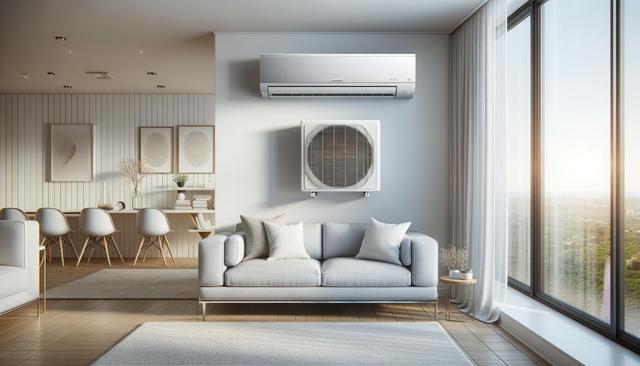Understanding How Ductless AC Works
Ductless air conditioning systems, also known as mini-split systems, operate by connecting an indoor air-handling unit to an outdoor compressor. Unlike traditional HVAC units that rely on a network of ducts to distribute conditioned air, ductless systems deliver air directly to the room where the unit is installed. This makes them ideal for homes without pre-existing ductwork or for additions and outbuildings where installing ducts would be impractical or too costly. To understand how ductless AC works, it’s helpful to know that the system uses refrigerant lines and electrical wiring to link the indoor and outdoor components, enabling efficient heating and cooling without the air losses often associated with ducted systems.
These systems come in single-zone or multi-zone configurations, making them highly versatile. Single-zone systems are perfect for conditioning individual rooms, while multi-zone setups allow multiple indoor units to connect to a single outdoor unit for broader coverage. This flexibility in design and installation is one of the key advantages of going ductless.
Energy Efficiency and Environmental Benefits
One of the standout features of ductless systems is their energy efficiency. Many of the energy-efficient ductless systems on the market today use inverter-driven compressors, which adjust their speed based on the cooling or heating needs of the space. This results in less energy waste and more consistent indoor temperatures. Unlike traditional HVAC systems that cycle on and off, inverter technology allows ductless systems to maintain a steady state, reducing the strain on the unit and lowering electricity usage.
In addition to saving on energy bills, ductless systems can also help reduce your carbon footprint. With no ducts to leak conditioned air, and more precise control over individual rooms, homeowners can minimize energy consumption. Some of the most highly rated ductless AC brands also offer models that meet ENERGY STAR® guidelines, further enhancing their eco-friendly credentials.
- Lower energy consumption compared to central AC systems
- Reduced air loss due to absence of ductwork
- Room-by-room control to avoid cooling unoccupied spaces
Installation Costs and Considerations
The cost of ductless AC installation can vary depending on several factors, including the size of the space, the number of indoor units required, and the complexity of the installation. On average, a single-zone system is less expensive to install than a multi-zone setup. While the upfront cost may be higher than a window unit or portable air conditioner, the long-term energy savings and system longevity often make it a worthwhile investment.
Installation typically requires less labor and disruption compared to installing ductwork, which can be a major advantage in older homes or buildings with limited space. When considering an upgrade to a ductless system, it’s important to consult with a qualified HVAC technician who can assess your needs and recommend the appropriate configuration.
- Single-zone systems: typically lower cost
- Multi-zone systems: higher initial investment, more flexibility
- Minimal construction work required
- Quick installation process (often within a day)
Maintenance Tips for Long-Term Performance
To keep a ductless system running efficiently, regular upkeep is essential. Following some basic ductless AC maintenance tips can help extend the life of your system and prevent costly repairs. The indoor air filters should be cleaned or replaced monthly, depending on usage, to maintain good air quality and system performance. The outdoor unit should also be kept free of debris, dirt, and leaves that can obstruct airflow.
In addition to these routine tasks, it’s advisable to schedule annual professional maintenance. This service typically includes a deep cleaning of internal components, refrigerant level checks, and a performance evaluation. By staying ahead of maintenance needs, homeowners can ensure that their energy-efficient ductless systems continue to operate at peak efficiency year-round.
- Clean or replace filters monthly
- Keep outdoor unit clear of obstructions
- Schedule professional service annually
- Check for unusual noises or performance changes
Common Issues and Troubleshooting Tips
Even with proper care, ductless systems may occasionally experience problems. Knowing basic troubleshooting ductless AC issues can help you address minor problems before they become serious. For instance, if the indoor unit isn’t cooling effectively, check the remote settings and ensure the filters are clean. Water leaks may indicate a clogged drain line, while unusual noises could signal loose parts or debris in the fan.
More serious problems, such as refrigerant leaks or electrical failures, should always be handled by a professional. However, being aware of common symptoms can help you communicate more effectively with your service provider and potentially reduce repair time and costs. Keeping a log of system performance and any issues can also be helpful for long-term system management.
- Check for power supply and remote control settings
- Inspect filters and drain lines regularly
- Listen for unusual sounds that might indicate mechanical issues
- Call a professional if refrigerant or electrical issues are suspected
Conclusion: Is a Ductless AC Upgrade Right for You?
Upgrading to a ductless AC system can be a smart move for homeowners seeking efficient, flexible climate control without the hassle and expense of ductwork. Whether you’re renovating, expanding your living space, or simply looking to enhance your home’s energy efficiency, ductless systems offer a modern solution with long-term benefits. By understanding how ductless AC works, considering the cost of ductless AC installation, and following recommended ductless AC maintenance tips, you can enjoy consistent comfort and improved indoor air quality across your home. Exploring options from best ductless AC brands and staying informed about troubleshooting ductless AC issues ensures that you’ll get the most out of your investment.




Leave a Reply